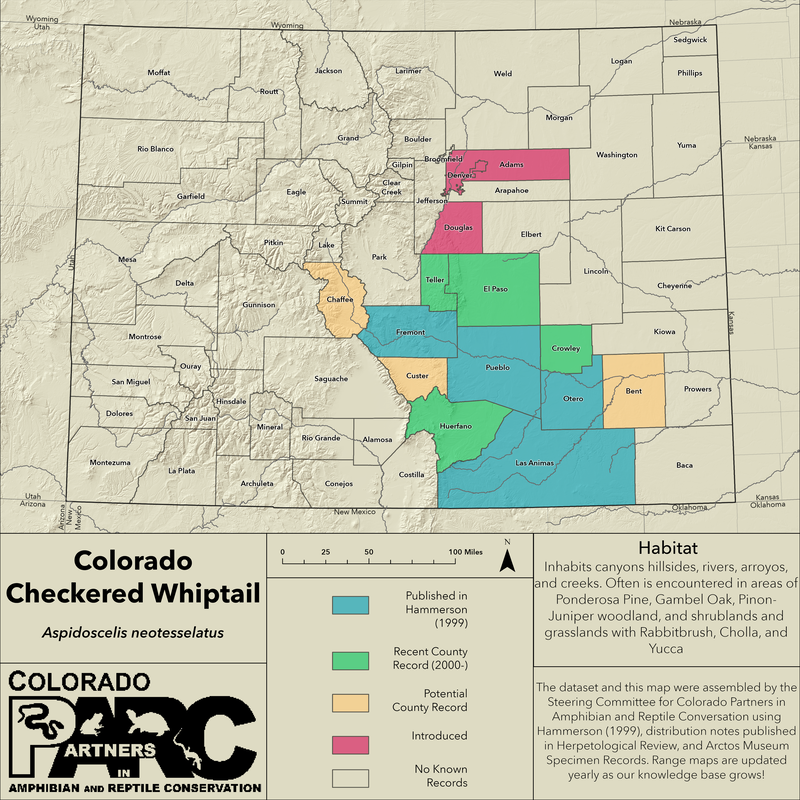|
Identification:
General Distribution: The native range of the Colorado Checkered Whiptail is restricted to the Arkansas River drainage of southeastern Colorado (see below), but established arrays have been reported in Grant County, Washington (Weaver et al. 2011), and Denver and Adams counties, Colorado (Livo et al. 2019).
Colorado Distribution: Colorado Checkered Whiptails occupy a native range restricted to the Arkansas River drainage and its tributaries in southeastern Colorado. Hammerson (1999) mapped a distribution that included four counties (Fremont, Las Animas, Otero, and Pueblo) but since the time of that publication the species has been documented in Crowley (Livo et al. 2019), El Paso and Teller (Taylor et al. 2015), and Huerfano (Warfel et al. 2015) counties in southeastern Colorado. In addition, established introduced arrays have been reported in Denver and Adams counties, Colorado (Livo et al. 2019). Colorado Checkered Whiptails have been observed at elevations between 4039 to 6952 feet in southeastern Colorado. Two instances of apparent waifs have been reported: a Colorado Checkered Whiptail escaped captivity in Bent County (Walker et al. 2012) and a single lizard was observed in Douglas County (Taylor et al. 2015). Activity: Activity can begin as early as about 8:00 a.m., but peak daily activity for Colorado Checkered Whiptails occurs between about 10:00 a.m. and 1:00 p.m. (Knopf 1966). Lizards alternate between basking and actively foraging, maintaining a body temperature of about 39°C (102°F). Cold, wet weather suppresses activity, while sunny, hot conditions encourage activity.
Although small numbers of Colorado Checkered Whiptails can be observed as early as mid-April, most activity begins by early to mid-May. By mid-August, adult activity tapers off with most large adults no longer active (Knopf 1966), although a few adults may be observed as late in the season as mid-September. The date hatchlings first appear appears to be related to summer temperatures, with hatching beginning by August in most years, but as early as 21 July in a year with above average summer temperatures (Livo et al. 2019). After mid-September virtually all lizards observed are young of the year, with the latest date of activity observed on November 9 (pers. obs.). Conservation Status: Nongame species. Considered by Colorado Parks and Wildlife as a species of Special Concern (not a statutory category) requiring a Scientific Collection License to capture or handle. Apparently extirpated from some areas of historical occurrence (Walker et al. 1996), but abundant elsewhere in its natural range.
NatureServe rank: G3 (Globally Vulnerable), S2 (State Imperiled). |
Habitat: Occupied habitat includes canyons, the vicinity of hillsides, rivers, arroyos, and creeks, as well as heavily altered habitats with slopes. This lizard often is encountered in areas of Ponderosa pine, Gambel’s oak, pinyon-juniper woodland, and shrublands and grasslands with rabbitbrush, cholla, and yucca (Knopf 1966; Aubry 2019; pers. obs.).
Diet: Colorado Checkered Whiptails forage opportunistically, and the most common food items for adults are grasshoppers and termites, while spiders and leafhoppers were the primary food items for young lizards (Paulissen et al. 1993). Kusaka et al. (2021) reported food items including a cicada, a moth, and larval lepidopterans. One instance of possible attempted cannibalism was observed by Wilcox and Livo (pers. obs.), in which an adult lizard appeared to track then lunge at a hatchling, which dashed away and escaped.
Defense: Colorado Checkered Whiptails depend on their ability to flee potential predators, usually dashing into the shelter of vegetation, into holes, or under rocks (pers. obs.).
Natural Predators: Predators reported by Knopf (1966) include Coachwhips (Masticophis flagellum) and likely other snakes, Eastern Collared Lizards (Crotaphytus collaris), and Roadrunners (Geococcyx californianus). In Denver, an American Kestrel (Falco sparverius) brought an adult Aspidoscelis neotesselatus to its nesting site (Todd Wilcox, pers. comm.). In Denver and Adams counties, American Racers (Coluber constrictor) are a likely predator on Colorado Checkered Whiptails.
|
Cited & Additional Resources
Aubry, L. M., D. Eifler, K. Utsumi, and S. S. French. 2019. Demographic assessment of the triploid parthenogenetic lizard Aspidoscelis neotesselatus at the northern edge of its range. Herpetological Conservation and Biology 14:411-419.
Caracalas, H., Hannah Reynolds, K. Ahern, M. A. Eifler, and D. A. Eifler. 2020. Natural History Notes: Aspidoscelis neotesselata (Colorado Checkered Whiptail). Behavior. Herpetological Review 50:326.
Crews, D., and K. T. Fitzgerald. 1980. “Sexual” behavior in parthenogenetic lizards (Cnemidophorus). Proceedings of the National Academy of Sciences 77:499-502.
Knopf, G. N. 1966. Reproductive behavior and ecology of the unisexual lizard, Cnemidophorus tesselatus Say. Ph.D. dissertation. University of Colorado, Boulder, CO.
Kusaka, C., D. A. Eifler, M. A. Eifler, L. J. Livo, L. M. Aubry, and J. M. Walker. 2021. Aspidoscelis neotesselatus (Colorado Checkered Whiptail): dietary observations and biology in the northern part of the range. Western Wildlife 8:1-7.
Livo, L. J., T. L. Wilcox, and H. L. Taylor. 2019. Established arrays of triploid, parthenogenetic Aspidoscelis neotesselatus (Colorado Checkered Whiptail) in Denver and Adams counties, Colorado: evidence of untapped ecological potential. Herpetological Review 50:690-694.
Paulissen, M. A., J. M. Walker, J. E. Cordes, and H. L. Taylor. 1993. Diet of diploid and triploid populations of parthenogenetic whiptail lizards of the Cnemidophorus tesselatus complex (Teiidae) in southeastern Colorado. Southwestern Naturalist 38:377-381.
Reeder, T. W., C. J. Cole, and H. C. Dessauer. 2002. Phylogenetic relationships of whiptail lizards of the genus Cnemidophorus (Squamata: Teiidae): a test of monophyly, reevaluation of karyotypic evolution, and review of hybrid origins. American Museum Novitates 3365:1-61.
Taylor, H. L., L. J. Livo, D. J. Martin, W. R. Maynard, A. Estep, R. Clawges, D. Roth, J. Kellner, and T. Jackson. 2015. New northern distribution records for pattern classes A, B, and D of Aspidoscelis neotesselata (Colorado Checkered Whiptail) in Colorado, and biogeographic sources of northern colonists. Herpetological Review 46:312-319.
Taylor, H. L., A. J. Wilmes, L. K. Garey, C. E. Montgomery, L. J. Livo, and J. M. Walker. 2016. Rare color-pattern misfits in indigenous arrays of parthenogenetic Aspidoscelis neotesselata (Colorado Checkered Whiptail). Herpetological Review 47:561-568.
Tucker, D. B., G. R. Colli, L. G. Giugliano, S. B. Hedges, C. R. Hendry, E. M. Lemmon, A. R. Lemmon, J. W. Sites, Jr., and R. A. Pyron. 2016. Methodological congruence in phylogenomic analyses with morphological support for teiid lizards (Sauria: Teiidae). Molecular Phylogenetics and Evolution 103:75-84.
Warfel, T., J. Warfel, and H. Johnson. 2021. Geographic Distribution: Aspidoscelis neotesselatus (Colorado Checkered Whiptail). Herpetological Review 52:83-84.
Weaver, R. E., A. P. O'Connor, J. L. Wallace, J. M. King, and J. M. Walker. 2011. Discovery of the parthenogenetic Colorado Checkered Whiptail, Aspidoscelis neotesselata (Squamata: Teiidae), in Washington state. Northwestern Naturalist 92:233-236.
Walker, J. M., J. E. Cordes, and H. L. Taylor. 1996. Extirpation of the parthenogenetic lizard Cnemidophorus tesselatus from historically significant sites in Pueblo County, Colorado. Herpetological Review 27:16-17.
Walker, J. M., J. E. Cordes, and H. L. Taylor. 1997. Parthenogenetic Cnemidophorus tesselatus complex (Sauria: Teiidae): a neotype for diploid C. tesselatus (Say, 1823), redescription of the taxon, and description of a new triploid species. Herpetologica 53:233-259.
Walker, J. M., H. L. Taylor, G. J. Manning, J. E. Cordes, C. E. Montgomery, L. J. Livo, S. Keefer, and C. Loeffler. 2012. Michelle's Lizard: identity, relationships, and ecological status of an array of parthenogenetic lizards (Genus Aspidoscelis: Squamata: Teiidae) in Colorado, USA. Herpetological Conservation and Biology 7:227-248.
Walker, J. M., B. K. Sullivan, and J. E. Cordes. 2021. Sanctioned nomenclature for triploid parthenogenetic Colorado Checkered Whiptail and for other taxa of the lizard genus Aspidoscelis (Family Teiidae). Herpetological Review 52:550-558.
Aubry, L. M., D. Eifler, K. Utsumi, and S. S. French. 2019. Demographic assessment of the triploid parthenogenetic lizard Aspidoscelis neotesselatus at the northern edge of its range. Herpetological Conservation and Biology 14:411-419.
Caracalas, H., Hannah Reynolds, K. Ahern, M. A. Eifler, and D. A. Eifler. 2020. Natural History Notes: Aspidoscelis neotesselata (Colorado Checkered Whiptail). Behavior. Herpetological Review 50:326.
Crews, D., and K. T. Fitzgerald. 1980. “Sexual” behavior in parthenogenetic lizards (Cnemidophorus). Proceedings of the National Academy of Sciences 77:499-502.
Knopf, G. N. 1966. Reproductive behavior and ecology of the unisexual lizard, Cnemidophorus tesselatus Say. Ph.D. dissertation. University of Colorado, Boulder, CO.
Kusaka, C., D. A. Eifler, M. A. Eifler, L. J. Livo, L. M. Aubry, and J. M. Walker. 2021. Aspidoscelis neotesselatus (Colorado Checkered Whiptail): dietary observations and biology in the northern part of the range. Western Wildlife 8:1-7.
Livo, L. J., T. L. Wilcox, and H. L. Taylor. 2019. Established arrays of triploid, parthenogenetic Aspidoscelis neotesselatus (Colorado Checkered Whiptail) in Denver and Adams counties, Colorado: evidence of untapped ecological potential. Herpetological Review 50:690-694.
Paulissen, M. A., J. M. Walker, J. E. Cordes, and H. L. Taylor. 1993. Diet of diploid and triploid populations of parthenogenetic whiptail lizards of the Cnemidophorus tesselatus complex (Teiidae) in southeastern Colorado. Southwestern Naturalist 38:377-381.
Reeder, T. W., C. J. Cole, and H. C. Dessauer. 2002. Phylogenetic relationships of whiptail lizards of the genus Cnemidophorus (Squamata: Teiidae): a test of monophyly, reevaluation of karyotypic evolution, and review of hybrid origins. American Museum Novitates 3365:1-61.
Taylor, H. L., L. J. Livo, D. J. Martin, W. R. Maynard, A. Estep, R. Clawges, D. Roth, J. Kellner, and T. Jackson. 2015. New northern distribution records for pattern classes A, B, and D of Aspidoscelis neotesselata (Colorado Checkered Whiptail) in Colorado, and biogeographic sources of northern colonists. Herpetological Review 46:312-319.
Taylor, H. L., A. J. Wilmes, L. K. Garey, C. E. Montgomery, L. J. Livo, and J. M. Walker. 2016. Rare color-pattern misfits in indigenous arrays of parthenogenetic Aspidoscelis neotesselata (Colorado Checkered Whiptail). Herpetological Review 47:561-568.
Tucker, D. B., G. R. Colli, L. G. Giugliano, S. B. Hedges, C. R. Hendry, E. M. Lemmon, A. R. Lemmon, J. W. Sites, Jr., and R. A. Pyron. 2016. Methodological congruence in phylogenomic analyses with morphological support for teiid lizards (Sauria: Teiidae). Molecular Phylogenetics and Evolution 103:75-84.
Warfel, T., J. Warfel, and H. Johnson. 2021. Geographic Distribution: Aspidoscelis neotesselatus (Colorado Checkered Whiptail). Herpetological Review 52:83-84.
Weaver, R. E., A. P. O'Connor, J. L. Wallace, J. M. King, and J. M. Walker. 2011. Discovery of the parthenogenetic Colorado Checkered Whiptail, Aspidoscelis neotesselata (Squamata: Teiidae), in Washington state. Northwestern Naturalist 92:233-236.
Walker, J. M., J. E. Cordes, and H. L. Taylor. 1996. Extirpation of the parthenogenetic lizard Cnemidophorus tesselatus from historically significant sites in Pueblo County, Colorado. Herpetological Review 27:16-17.
Walker, J. M., J. E. Cordes, and H. L. Taylor. 1997. Parthenogenetic Cnemidophorus tesselatus complex (Sauria: Teiidae): a neotype for diploid C. tesselatus (Say, 1823), redescription of the taxon, and description of a new triploid species. Herpetologica 53:233-259.
Walker, J. M., H. L. Taylor, G. J. Manning, J. E. Cordes, C. E. Montgomery, L. J. Livo, S. Keefer, and C. Loeffler. 2012. Michelle's Lizard: identity, relationships, and ecological status of an array of parthenogenetic lizards (Genus Aspidoscelis: Squamata: Teiidae) in Colorado, USA. Herpetological Conservation and Biology 7:227-248.
Walker, J. M., B. K. Sullivan, and J. E. Cordes. 2021. Sanctioned nomenclature for triploid parthenogenetic Colorado Checkered Whiptail and for other taxa of the lizard genus Aspidoscelis (Family Teiidae). Herpetological Review 52:550-558.
Account compiled by: Lauren J. Livo
Reviewed by:
Last Updated: 1/30/2023 by Anthony Berardi
Reviewed by:
Last Updated: 1/30/2023 by Anthony Berardi


